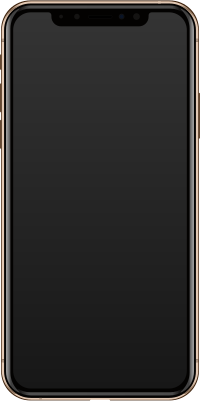Welcome To DSD Brands
Welcome To DSD Brands
We are going over the best phones since 2007
Credits to and special thank to Wikipedia and companies and manufactures of Apple, Samsung etc, they own the art work and the articles on the phones.
2007:
The Nokia 6500 classic is a mobile phone from Nokia announced on May 31, 2007. The phone runs the Series 40 platform. The case is made of brushed aluminium. At just 9.5 mm thick, the 6500 classic was Nokia's thinnest phone when released in October 2007. It is notable for being Nokia's few Series 40 phones with a large internal memory, 1 GB (along with the Nokia 7900 and others). It also had a similar sliding variant called Nokia 6500 slide. Both of them were the first Nokia phones where the miniUSB port was replaced by microUSB.
2008:
The Motorola Razr (styled RAZR, pronounced "razor"; sometimes also Siliqua) was a series of mobile phones by Motorola, part of the 4LTR line. The V3 was the first phone released in the series and was introduced in July 2004[1] and released in the market in the third quarter of 2004.[2] The V3 model was followed soon thereafter by the much improved V3i with a collaboration with Apple Inc. for iTunes to be built-in.
Because of its striking appearance and thin profile, it was initially marketed as an exclusive fashion phone. But, within a year, its price was lowered and as a result it sold over 50 million units by July 2006. Leading up to the release, Motorola's Cell phone division sales were stagnant and losing money. This success made the division profitable again. [3] Over the Razr's four-year run, the V3 model sold more than 130 million units, becoming the best-selling clamshell phone in the world to date.[4]
The Razr series was marketed until July 2007, when the succeeding Motorola Razr2 series was released. The succeeding models were the V8, the V9, and the V9m.[5] However, Razr2 sales were not as good as the original, with consumers moving to competing products.[6] Because Motorola relied so long upon the Razr and its derivatives[7][8] and was slow to develop new products in the growing market for feature-rich touchscreen and 3G phones,[9] the Razr appeal declined, leading Motorola to eventually drop behind Samsung and LG in market share for mobile phones.[10] Motorola's strategy of grabbing market share by selling tens of millions of low-cost Razrs cut into margins and resulted in heavy losses in the cellular division.[11][12]
In October 2011, Motorola resurrected the Razr brand for a line of Android smartphones: the Droid Razr for Verizon Wireless (known simply as the "Motorola RAZR" on other networks) and an improved variant, the Droid Razr Maxx.[13][14] The new "Razr" line shares the trademark thinness and stylized tapered corners with the original. The series was marketed until 2013.
In December 2018, Lenovo as now-owners of the Motorola and Razr brands filed a patent with the World Intellectual Property Organization (WIPO) for a foldable smartphone with a design reminiscent of the Razr V3.[15] According to The Wall Street Journal, the phone will be released as an exclusive on Verizon Wireless with a starting price of $1,500 but neither the phone itself nor the details have been publicly confirmed by Lenovo.
2009:
The iPhone 3GS (originally styled iPhone 3G S)[8] is a smartphone that was designed and marketed by Apple Inc. It is the third generation iPhone, successor to the iPhone 3G. It was introduced on June 8, 2009,[4] at the WWDC 2009 which took place at the Moscone Center, San Francisco.
This iPhone is named "3GS" where "S" stood for Speed (Phil Schiller had mentioned it in the launch keynote).[9] Improvements include performance, a 3-megapixel camera with higher resolution and video ability, voice control,[10] and support for 7.2 Mbit/s HSDPA downloading (but remains limited to 384 kbps uploading as Apple had not implemented the HSUPA protocol).[11] It was released in the United States, Canada, and six European countries on June 19, 2009,[4] in Australia and Japan on June 26, and internationally in July and August 2009.
The iPhone 3GS runs Apple's iOS operating system. It was succeeded as Apple's flagship smartphone in 2010 by the iPhone 4. In June 24, an 8GB model was released, discontinuing the 16 and 32GB models. However, the 3GS continued in production until September 2012 when the iPhone 5 was announced.

2010:
The iPhone 4 is a smartphone that was designed and marketed by Apple Inc. It is the fourth generation iPhone, succeeding the 3GS and preceding the 4S. Following a number of notable leaks, the iPhone 4 was first unveiled on June 7, 2010, at Apple's Worldwide Developers Conference in San Francisco,[8] and was released on June 24, 2010, in the United States, United Kingdom, France, Germany and Japan. The iPhone 4 introduced a new hardware design to the iPhone family, which Apple's CEO Steve Jobs touted as the thinnest smartphone in the world at the time; it consisted of a stainless steel frame which doubles as an antenna, with internal components situated between aluminosilicate glass.[9] The iPhone 4 also introduced Apple's new high-resolution "Retina Display" with a pixel density of 326 pixels per inch while maintaining the same physical size and aspect ratio as its precursors. The iPhone 4 also introduced Apple's A4 system-on-chip, along with iOS 4—which notably introduced multitasking functionality and Apple's new FaceTime video chat service. The iPhone 4 was also the first iPhone to include a front-facing camera, and the first to be released in a version for CDMA networks, ending AT&T's period as the exclusive carrier of iPhone products in the United States.
The iPhone 4 received generally positive reception, with critics praising its revamped design and more powerful hardware in comparison to previous models. While it was a market success, with over 600,000 pre-orders within 24 hours, the release of the iPhone 4 was plagued by highly publicized reports that abnormalities in its new antenna design caused the device to lose its cellular signal if held in a certain way. Most human contact with the phone's outer edge would cause a significant decrease in signal strength.
The iPhone 4 spent the longest time as Apple's flagship iPhone model at fifteen months. Although the succeeding 4S was announced in October 2011, the 4 continued to be sold as a midrange model until September 2012, and thereafter as the entry-level offering in Apple's lineup until September 2013 with the announcement of the iPhone 5S/iPhone 5C. The iPhone 4 had the longest lifespan of any iPhone ever produced, spanning close to four years and available in some developing countries until early 2015.
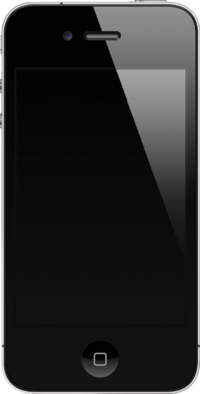
2011:
The Samsung Galaxy S II is a touchscreen-enabled, slate-format Android smartphone designed, developed, and marketed by Samsung Electronics. It has additional software features, expanded hardware, and a redesigned physique compared to its predecessor, the Samsung Galaxy S. The S II was launched with Android 2.3 "Gingerbread", with updates to Android 4.1.2 "Jelly Bean".
Samsung unveiled the S II on 13 February 2011 at the Mobile World Congress (MWC) in Barcelona.[6] It was one of the slimmest smartphones of the time, mostly 8.49 mm thick, except for two small bulges which take the maximum thickness of the phone to 9.91 mm.[7] The Galaxy S II has a 1.2 GHz dual-core "Exynos" system on a chip (SoC) processor,[8] 1 GB of RAM, a 10.8 cm (4.3 in) WVGA Super AMOLED Plus screen display and an 8-megapixel camera with flash and 1080p full high definition video recording. It is one of the first devices to offer a Mobile High-definition Link (MHL),[9] which allows up to 1080p uncompressed video output to an MHL enabled TV or to an MHL to HDMI adapter, while charging the device at the same time. USB On-The-Go is supported.[10][11]
The user-replaceable battery gives up to ten hours of heavy usage, or two days of lighter usage.[12] According to Samsung, the Galaxy S II is capable of providing 9 hours of talk time on 3G and 18.3 hours on 2G.[12][13]
The Galaxy S II was popular and a huge success both critically and commercially,[14][15] selling 3 million units within its first 55 days on the market.[16] It was succeeded by the Samsung Galaxy S III in May 2012.
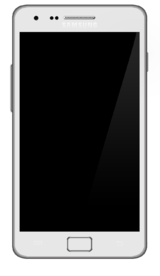
2012:
The iPhone 5 is a smartphone that was designed and marketed by Apple Inc. It is the sixth generation of the iPhone succeeding the iPhone 4S and preceding the iPhone 5S and iPhone 5C. Formally unveiled as part of a press event on September 12, 2012, it was released on September 21, 2012.[12] The iPhone 5 is the first iPhone to be announced in September and, setting a trend for subsequent iPhone releases, the first iPhone to be completely developed under the guidance of Tim Cook and the last iPhone to be overseen by Steve Jobs.
The iPhone 5 featured major design changes in comparison to its predecessor. These included an aluminum-based body which was thinner and lighter than previous models, a taller screen with a nearly 16:9 aspect ratio, the Apple A6 system-on-chip, LTE support, and Lightning, a new compact dock connector which replaced the 30-pin design used by previous iPhone models. This was the second Apple phone to include its new Sony-made 8 MP camera, which was first introduced on the iPhone 4S.
Apple began taking pre-orders on September 14, 2012,[2] and over two million were received within 24 hours.[6] Initial demand for the iPhone 5 exceeded the supply available at launch on September 21, 2012, and was described by Apple as "extraordinary", with pre-orders having sold twenty times faster than its predecessors. While reception to the iPhone 5 was generally positive, consumers and reviewers noted hardware issues, such as an unintended purple hue in photos taken, and the phone's coating being prone to chipping. Reception was also mixed over Apple's decision to switch to a different dock connector design, as the change affected iPhone 5's compatibility with accessories that were otherwise compatible with previous iterations of the line.
The iPhone 5 was officially discontinued by Apple on September 10, 2013 with the announcement of its successors, the iPhone 5S and the iPhone 5C.[13] The iPhone 5 has the joint second-shortest lifespan of any iPhone ever produced with only twelve months in production, breaking with Apple's standard practice of selling an existing iPhone model at a reduced price upon the release of a new model. This was broken by the iPhone X which only had ten-months in production from November 2017 to September 2018; and tied with the iPhone XS which had twelve-months from September 2018 to September 2019.
It was replaced as a midrange and then an entry-level device by the iPhone 5C; the 5C internal hardware specifications are almost identical to the 5 albeit having a less expensive polycarbonate exterior. The iPhone 5 supports iOS 6, 7, 8, 9 and 10. The iPhone 5 is the second iPhone to support five major versions of iOS after the iPhone 4S.
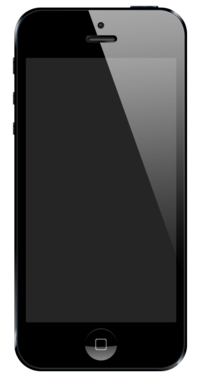
2013:
The iPhone 5C (marketed with a stylized lowercase 'c' as iPhone 5c) is a smartphone that was designed and marketed by Apple Inc. It is the sixth generation of the iPhone. The device was part of the iPhone series and was unveiled on September 10, 2013,[5][6] and released on September 20, 2013,[7][8] along with its higher-end counterpart, the iPhone 5S.
The iPhone 5C is a variant of the iPhone 5, with similar hardware specifications but a hard-coated polycarbonate shell instead of the aluminium of the original iPhone 5. The iPhone 5C was available in several color options, and shipped with iOS 7. The iPhone 5C was sold at a discounted price point in comparison to the 5S: unlike Apple's usual practice of lowering the price of the previous model upon release of a new version, the iPhone 5 was explicitly discontinued and replaced by the 5C. On September 9, 2014, the 16 and 32 GB iPhone 5C models were replaced by the 8 GB model with the announcement of the iPhone 6 and iPhone 6 Plus. On September 9, 2015, the 8 GB version was discontinued when the iPhone 6S was announced.

2014:
The iPhone 6 and iPhone 6 Plus are smartphones designed and marketed by Apple Inc. It is the eighth generation of the iPhone, succeeding the iPhone 5S, and was announced on September 9, 2014 and released on September 19, 2014.[18] The iPhone 6 and iPhone 6 Plus jointly were themselves replaced as the flagship devices of the iPhone series by the iPhone 6S and iPhone 6S Plus on September 9, 2015. The iPhone 6 and 6 Plus include larger 4.7 and 5.5 inches (120 and 140 mm) displays, a faster processor, upgraded cameras, improved LTE and Wi-Fi connectivity and support for a near field communications-based mobile payments offering.[19][20]
The iPhone 6 and 6 Plus received positive reviews, with critics regarding their redesign, specifications, camera, and battery life as being improvements over previous iPhone models. However, aspects of the design of iPhone 6 were also panned, including plastic strips on the rear of the device for its antenna that disrupted the otherwise metal exterior, and the screen resolution of the standard-sized iPhone 6 being lower than other devices in its class. Pre-orders of the iPhone 6 and iPhone 6 Plus exceeded four million within its first 24 hours of availability—an Apple record.[21] More than ten million iPhone 6 and iPhone 6 Plus devices were sold in the first three days, another Apple record.[22] During its lifespan, the iPhone 6 and 6 Plus sold 220 million in total, which makes them the best selling iPhone models, so far, and one of the most successful phones to date.
Despite their positive reception, the iPhone 6 and 6 Plus have been the subject of several hardware issues, including most prominently, being susceptible to bending under hard pressure (dubbed "Bendgate"), and as a byproduct of this lack of rigidity, the touchscreen's internal hardware being susceptible to losing its connection to the phone's logic board (nicknamed "Touch Disease"). Additionally, some iPhone 6 Plus models were the subject of camera issues, including some with malfunctioning optical image stabilization or otherwise defects on rear cameras.
The iPhone 6 and 6 Plus were moved to the midrange spot in Apple's iPhone lineup when the iPhone 6S and 6S Plus were released in September 2015. The iPhone 6 and 6 Plus were discontinued in most markets on September 7, 2016 when Apple announced the iPhone 7 and iPhone 7 Plus. Their spot as the entry-level iPhone was replaced by the iPhone SE, which was released earlier on March 31, 2016. The iPhone 6 was relaunched with 32 GB of storage in Asian markets in February 2017 as a midrange/budget iPhone. It was later expanded to Europe,[23][24] before hitting the US markets in May 2017,[25] and Canada in July 2017.[26] The iPhone 6 and 6 Plus supported iOS 8, 9, 10, 11 and 12 before being dropped by iOS 13, and they are the third to support five versions of iOS after the iPhone 4S and the iPhone 5.
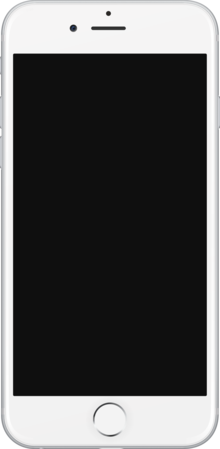
2015:
The iPhone 6S and iPhone 6S Plus (stylized and marketed as iPhone 6s and iPhone 6s Plus) are smartphones that were designed, developed, and marketed by Apple Inc. It is the ninth generation of the iPhone. They were announced on September 9, 2015, at the Bill Graham Civic Auditorium in San Francisco by Apple CEO Tim Cook, with pre-orders beginning September 12 and official release on September 25, 2015. The iPhone 6S and 6S Plus were succeeded by the iPhone 7 and iPhone 7 Plus on September 7, 2016[19] and were discontinued with the announcement of the iPhone XS, iPhone XS Max, and iPhone XR on September 12, 2018.
The iPhone 6S has a similar design to the iPhone 6 but includes updated hardware, including a strengthened chassis and upgraded system-on-chip, a 12-megapixel camera, improved fingerprint recognition sensor, LTE Advanced support, and "Hey Siri" capabilities without needing to be plugged in. The iPhone 6S also introduces a new hardware feature known as "3D Touch", which enables pressure-sensitive touch inputs.
The iPhone 6S had a mostly positive reception. While performance and camera quality were praised by most reviewers, the addition of 3D Touch was liked by one critic for the potential of entirely new interface interactions, but disliked by another critic for not providing users with an expected intuitive response before actually using the feature. The battery life was criticized, and one reviewer asserted that the phone's camera was not significantly better than the rest of the industry. The iPhone 6S set a new first-weekend sales record, selling 13 million models, up from 10 million for the iPhone 6 in the previous year. However, Apple saw its first-ever quarterly year-over-year decline in iPhone sales in the months after the launch, credited to a saturated smartphone market in Apple's biggest countries and a lack of iPhone purchases in developing countries.

2016:
Samsung Galaxy S7, Samsung Galaxy S7 Edge and Samsung Galaxy S7 Active are Android-based smartphones manufactured, released and marketed by Samsung Electronics. The S7 series serves as the successor to the Galaxy S6, S6 Edge, S6 Edge+ and S6 Active released in 2015. The S7 and S7 Edge were officially unveiled on 21 February 2016 during a Samsung press conference at Mobile World Congress, with a European and North American release on 11 March 2016.[7][8] The S7 Active was unveiled on 4 June 2016, and released on AT&T in the United States on 10 June 2016.[2]
The Galaxy S7 is an evolution of the prior year's model, with upgraded hardware, design refinements, and the restoration of features removed from the Galaxy S6, such as IP certification for water and dust resistance, as well as expandable storage. Succeeding the S6 and S6 Edge+, respectively, the S7 is produced in a standard model with a display size of 5.1-inch (130 mm) as well as an Edge variant whose display is curved along the wide sides of the screen and also has a larger 5.5-inch (140 mm) display. The S7 Active features a thicker more rugged frame and an increased battery capacity. The Galaxy S7 and S7 Edge are the last two phones in the Samsung Galaxy S series to have a physical home button with a front-sided fingerprint sensor embedded in the button (the S7 Active being the last in the Active series to feature three physical buttons with the fingerprint reader embedded home button, when not considering the prematurely discontinued Galaxy Note 7), and the last Samsung Galaxy S series phones to be equipped with a MicroUSB-B port, which has been replaced with USB-C afterwards.
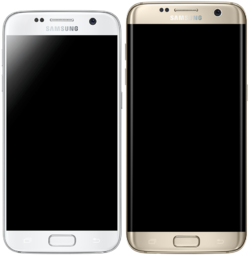
2017:
iPhone X (Roman numeral "X" pronounced "ten")[9][10] is a smartphone designed, developed, and marketed by Apple Inc. It was the eleventh generation of the iPhone. It was announced on September 12, 2017, alongside the iPhone 8 and iPhone 8 Plus, at the Steve Jobs Theater in the Apple Park campus. It was available to pre-order on October 27, 2017 with the iPhone X being released on November 3, 2017.
The iPhone X was intended to showcase what Apple considered the technology of the future. Using a glass and stainless-steel form factor and "bezel-less" design, shrinking the bezels, and not having a "chin", unlike many Android phones. It was the first iPhone to use an OLED screen or to offer wireless charging. The home button was replaced with a new type of authentication called Face ID, which used sensors to scan the user's face to unlock the device. This face-recognition capability also enabled emojis to be animated following the user's expression (Animoji). With a bezel-less design, iPhone user interaction changed significantly, using gestures to navigate the operating system rather than the home button used in all previous iPhones. At the time of its November 2017 launch, its price tag of US$999 also made it the most expensive iPhone ever, with even higher prices internationally due to additional local sales and import taxes.
The iPhone X received generally positive reviews. Its display and build quality were universally praised, and the camera also scored positively on tests. The phone received polarized reception due to the sensor housing "notch" at the top of the screen and the introduction of an all-new authentication method. The notch was heavily mocked by users on social media, although app developers responded either neutrally or positively to the changes it brought to the user experience in their apps and games. Reviewers had mixed reactions, with some condemning it and others acknowledging it as unusual in the first moments of use before getting accustomed to its presence. Face ID facial recognition was praised for its simple setup, but criticized for requiring direct eyes on the screen, though that option can be disabled within the system preferences.
Along with the iPhone 6s, its Plus variant, and the iPhone SE, the iPhone X was discontinued on September 12, 2018 following the announcement of the new iPhone XS, iPhone XS Max and iPhone XR devices. As a result, with a shelf life of just over 10 months, the iPhone X had the shortest ever tenure as the flagship device in the history of the iPhone.
On November 22, 2018, Apple has reportedly resumed production of the iPhone X due to weak sales of its successors. The iPhone X remains discontinued,[11] but as of February 2019, Apple started selling refurbished models for $769.[12][13] In September 2019, Apple reduced the price for refurbished iPhone X models to $679.

2018:
iPhone XR (stylized and marketed as iPhone Xʀ; Roman numeral "X" pronounced "ten")[13][14] is a smartphone designed and manufactured by Apple Inc. It is the twelfth generation of the iPhone. It was announced by Phil Schiller on September 12, 2018, at the Steve Jobs Theater in the Apple Park campus, alongside the higher-priced iPhone XS and iPhone XS Max. Pre-orders began on October 19, 2018, with an official release on October 26, 2018.[15]
The phone has a 6.1-inch "Liquid Retina" LCD display, which Apple claims is the "most advanced LCD in the industry."[16] It is the least expensive device in Apple's iPhone X line of devices, with a starting price of $749 in the United States, $1029 in Canada, £749 in the United Kingdom, €849 in the Eurozone countries, and 6499 yuan in China. It features the same processor as the XS and XS Max, the Apple A12 Bionic chip built with a 7 nanometer process, which Apple claims to be the "smartest and most powerful chip" ever put into a smartphone.[15]
It is available in six colors: black, white, blue, yellow, coral (a shade of pink and orange), blue,and (Product)RED. The XR is available in three storage capacities: 64GB, 128GB, and 256GB. It is the second iPhone to be released in yellow and blue, the first being the iPhone 5C in 2013.[15] Internationally, the phone supports dual SIMs through a Nano-SIM and an eSIM. In mainland China, Hong Kong, and Macau, dual Nano-SIM (in a single tray) is offered instead.[17][18]
Despite receiving some criticism for its lower display resolution in comparison to previous iPhone models at roughly the same price point, the XR received mostly positive reviews from critics and users after its release. The XR is Apple's best selling 2018 model. According to Apple, the XR battery lasts up to one-and-a-half hours longer than its direct predecessor, the iPhone 8 Plus.

2019:
The iPhone 11 Pro and 11 Pro Max are smartphones designed, developed and marketed by Apple Inc. They are the 13th-generation flagships of the iPhone, succeeding the iPhone XS and XS Max, respectively. Apple CEO Tim Cook unveiled the devices alongside a lower-end model, the iPhone 11, on September 10, 2019, at the Steve Jobs Theater at Apple Park. Pre-orders began on September 13, 2019, and went on sale by September 20.[5]
Changes from previous devices include the triple-lens rear camera system and the A13 Bionic chip.[6] The 11 Pro is Apple's first iPhone to feature a "pro" designation, which was previously used only for larger Apple devices,[7] and the first to include in the box an 18W fast charger and a Lightning to USB-C cable that allows connection to current Mac computers.
